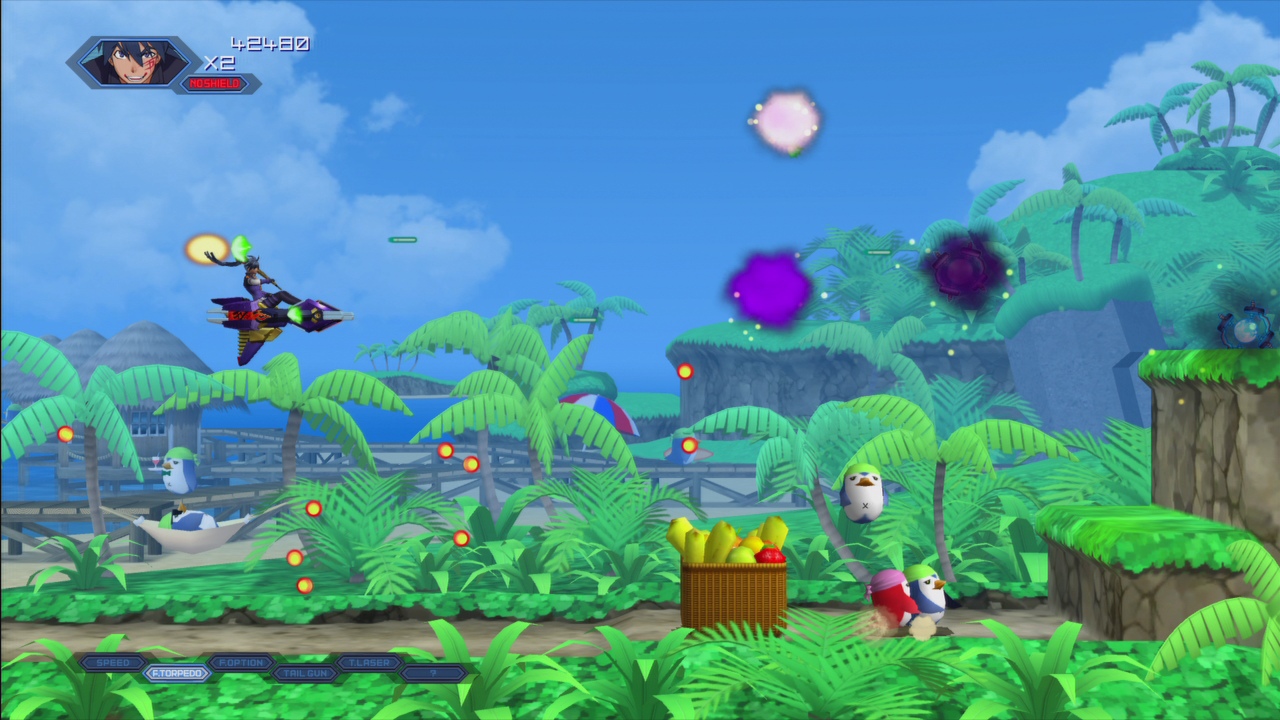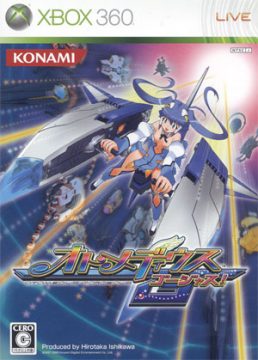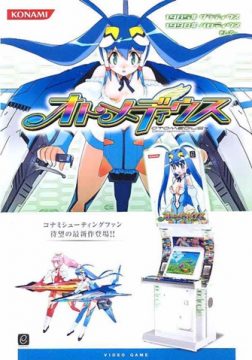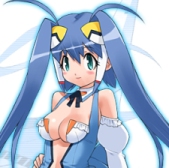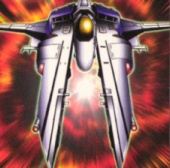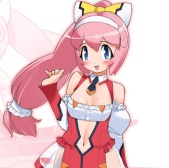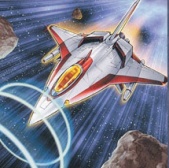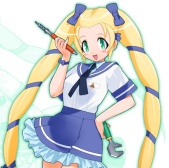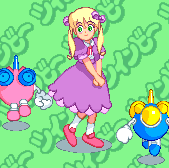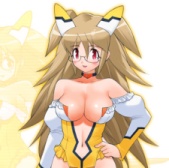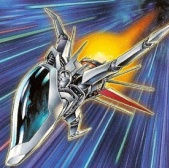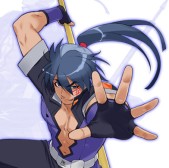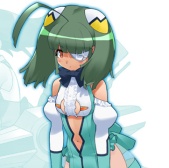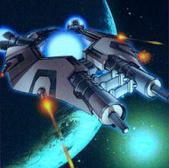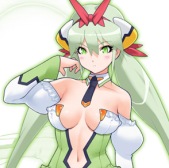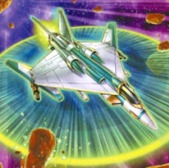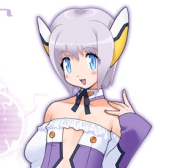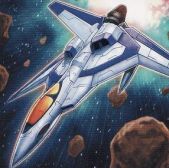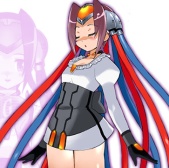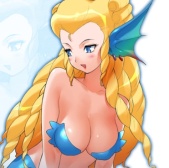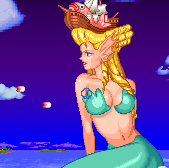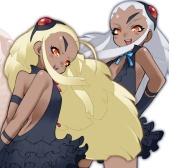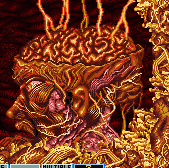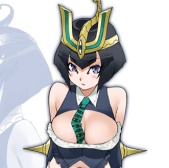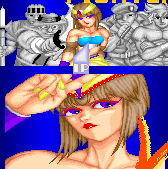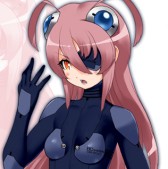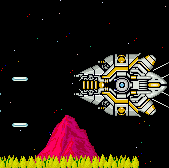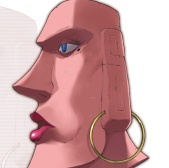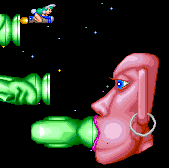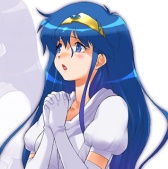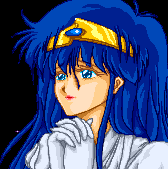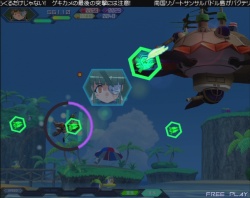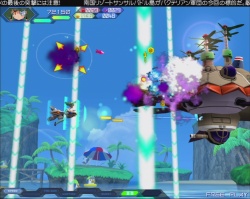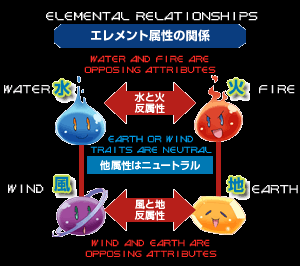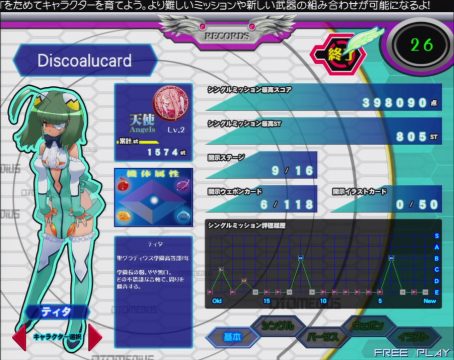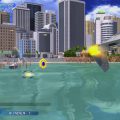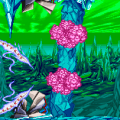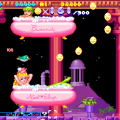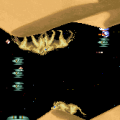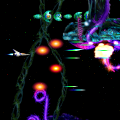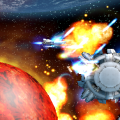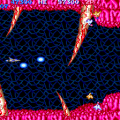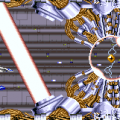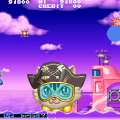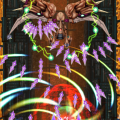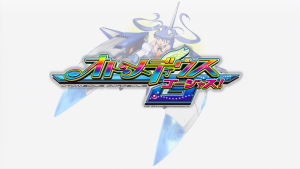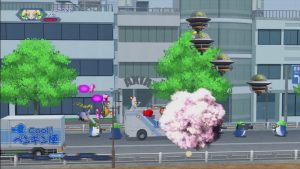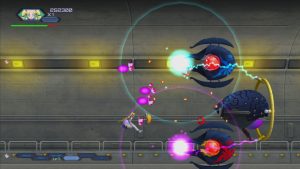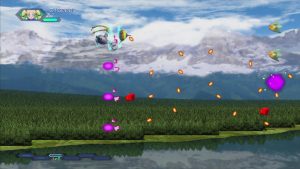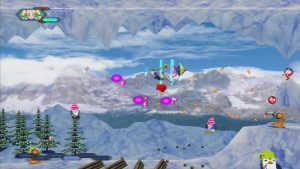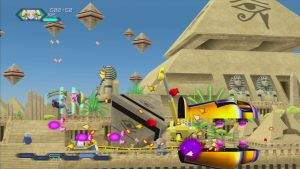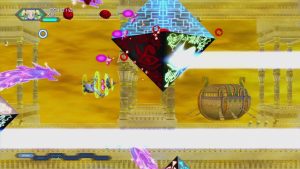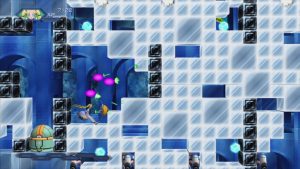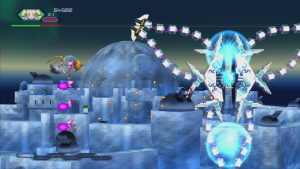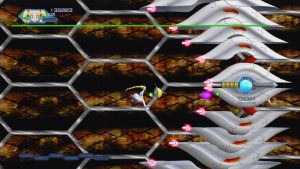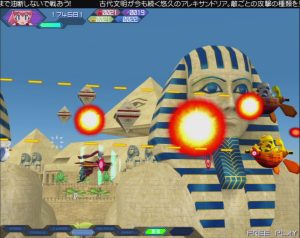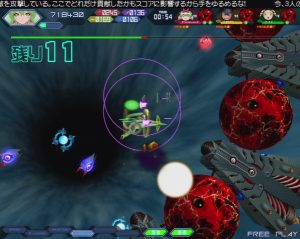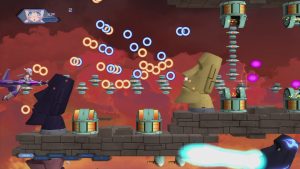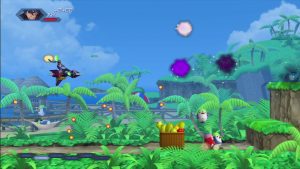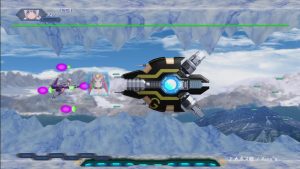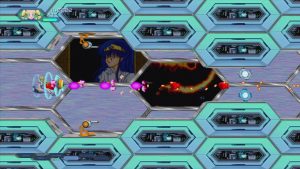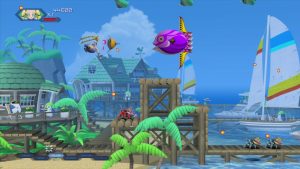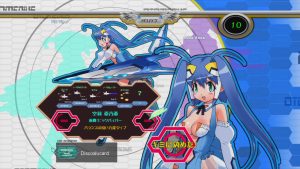- Otomedius
- Otomedius Excellent
From a thematic standpoint, the shooter landscape of the early 21st century has varied greatly from the years before it. In the 80s and 90s, a vast majority of the genre was about piloting spaceships, flying in outer space, shooting space bad guys. Somewhere around the mid-2000s, it began to branch artistically, moving away from sci-fi to other themes. One of the most popular devices was to replace the boring old flying ship with a hot chick, and call it a day. It’s hard to say what popularized this, though it’s reasonable to respect the influence of Touhou Project and other similar doujin games, which married a cutesy aesthetic with hardcore shooter mechanics. This can be seen in numerous games from the era, including Cave’s Mushihime-sama and Ibara, Warashi’s Triggerheart Exelica, and Konami’s Otomedius series. The name is a portmanteau of the Japanese word “otome”, meaning (roughly) a young girl, and, of course, Gradius.
Historically Konami had been more diverse than other companies when it came to shoot-em-ups. Although a plethora of their games fit the standard mold, including Gradius, one of the forefathers of the modern genre, they had played around a bit with the aesthetics, introducing TwinBee, largely recognized as the first cute-em-up, as well as Parodius, which took the essentials of Gradius and made them incredibly silly. Otomedius takes the “moe” trend of anime and manga from the early 2000s, with stories featuring lots of cute girls, and injects it into a shooter.
The major difference between Otomedius and other similarly styled shooters lies in how the girls are integrated into the game. Japan has long been recognized as a “culture of cute”, being the birthplace of properties like Hello Kittyand all. A recent trend has been anthropomorphing basically anything you can think of, and turning them into cute girls, with subjects ranging from Windows operating systems to World War II fighter jets to anime mechas, the latter termed “mecha musume” or “mecha girls”. The ladies of Otomedius seem to pilot their respective ships, known as Riding Vipers or RVs, by wearing them around their waist, which looks necessarily odd but emphasizes their characterization. The ships themselves are based on a number of classic Konami properties, including the Vic Viper and Lord British from Gradius / Salamander, the Flintlock from Xexex, and others, and the character artwork is provided by Mine Yoshizaki, mostly famous for the goofy manga Sgt. Frog/Keroro Gunsou, but had also worked on Konami shooters of the past with Detana! TwinBee.
The results are, like most things associated with the moe phenomenon, vaguely embarrassing. The girls wear ridiculous outfits, cater to a variety of popular fetishes, and have breasts so large that they’re spilling out of their uniforms, or are otherwise shaped like middle schoolers. While it’s bright and attractive in a colorful sense, it’s also rather off-putting, especially for those outside of the otaku audience. What’s more is that many other shooters that use similarly sexualized art styles, like Cave’s Mushihime-sama, Deathsmilies, Ibara, and the Touhou entries, the core games are strong enough that make it possible to look past their exterior. The Otomedius games, of which there are two, are not terrible, but they are a bit lower on the quality foodchain than most of Konami’s 90s era shooters, making them feel vaguely exploitive.
The original Otomedius was released in arcade in 2007. A Xbox 360 version was only released in Japan in 2008 under the name Otomedius Gorgeous, which includes a port of the arcade game, along with a new “Gorgeous” mode specifically balanced for console play. The second game is Otomedius Excellent, also for the Xbox 360, which was lucky enough to be released in North America in 2011.
The manga included with the Xbox 360 of Otomedius vaguely details the plot – the Bacterians, the bad guys of the Gradius games, have invaded Earth and blended in with the population. The female head characters, also from outer space, have come to protect the earthlings, and enroll in a local high school so they themselves can blend in. There are stupid juvenile romantic hijinx involved, but none of that matters to the core game, which ignores all of that and, at a very basic level, plays just like Gradius. (There’s also some kind of ridiculous attempt to fit all of the Konami shooter games into one continuous “multiverse” canon, although it’s entirely contained to supplementary material.)
There are several characters to play as, each with their own default arsenal and special attacks, known as Bursts. Most of them are based off ships or characters from other Konami games, and the same goes with many of the bosses. Strangely, most of the boss characters only appear in portrait form before and after battles to taunt you – they are either commanding a minion or piloting a ship, so they don’t actually feature in the play field.
The Good Guys
Aoba Anoa
RV: Vic Viper
The main character, given her presence at the forefront of all official pieces of art. She technically has black hair, but it turns blue when she transforms into her TV form. Her default weapon loadout includes a standard downward firing missile, the two shot Double, a straight-forward laser, and the usual ship-shadowing Options; in otherwords, the typical Gradius arsenal since the beginning. In the sequel she also has an unlockable form called Hyper Anoa, where she pilots the Metalion, the ship from the MSX Gradius 2.
Erul Tron
RV: Lord British
The Lord British was the name of the second player vessel in Salamander / Life Force. Although essentially identical to the Vic Viper except in color, its designs and arsenal was diversified a bit with Gradius Gaiden. Erul’s default weapons are a Twin Missile, the Ripple laser (which was also introduced in Salamander as an alternate to the standard laser), and the Cyclone laser, which shifts along with the movement of your ship. Her options are also known as multiples, although other than a slight delay in movement, are identical to Aoba’s/Vic Viper’s.
Madoka
RV: The Murdoch Viper
Madoka hails from the Twinbee series, and is the granddaughter of the evil Dr. Mardock, the nemesis of Pop’n Twinbee. Despite appearing prominently in the game’s artwork, she’s never actually been a playable character in the shooter series, until now, where she rides a strange bicycle-like contraption of her own design. She’s equipped with a Vulcan cannon and the same Rocket Punch as Twinbee had in the Parodius games. In the original Otomedius her options look the same as everyone elses, but she calls on the help of Twinbee, Winbee and Gwinbee in the sequel.
Diol Twee
RV: Serenity Viper
The oldest of the group, as denoted by her extremely ample bosom. Her ship is based off the Flintlock from XEXEX, although that’s a bit hard to see since, unlike the other girls, her yellow outfit is not color coded to ship she corresponds to. The only telltale sign is the creepy spiny tentacle thing that’s usually wrapped around here, which are called “flints”, and acts as both her D-Burst attack (much like fully charged shot in XEXEX) as well as her options, which float around randomly but lock into place when fiting.
Emon 5
RV: Xiel-Viper
The lone male cast member, Emon 5 is inspired by Goemon, who was a playable character in both the MSX Parodius and the SFC version of Gokujou Parodius. (Beyond his spikey hair and large kiseru (pipe), the numeral “5” is pronounced “go”, so just rearrange the syllables and you have his name.) His weapons are taken from Thunder Cross.
Tita Nium
RV: Big Core Examine
Representative of the “crippled girl” fetish, Tita Nium is theorized to be a Bacterian. Her RV is a minature version of the Big Core, the recurring boss since the very first Gradius game.
Esmeralda
RV: Jade Knight
Esmerelda is based on the Jade Knight from Gradius Gaiden, featuring that ships Round Laser and Pulse Laser. Only available in the first Otomedius as DLC in the console version, but is unlockable in Otomedius Excellent after beating the game with Erul Tron.
Poini Coon
RV: Falchion Beta
Esmerelda’s wingwoman is based on the Falchion Beta from Gradius Gaiden, which in turn was loosely based on the fighter from the 3D Famicom shooter Falsion, with a Rolling Missile and Auto-Aim gun. Only available in the first Otomedius as DLC in the console version, but is unlockable in Otomedius Excellent after beating the game with Esmeralda.
The Bad Guys
Eliza
This gigantic mermaid is the second boss from Gokujou Parodius. In Otomedius, she’s the boss of San Salvador Island, and commands a giant seal riding a pink clamshell to do her bidding.
The Gofa Sisters
Gofa is the final enemy of Gradius II. It had long been transliterated as “Gofer”, but the official Konami translation has said otherwise. He was a gigantic messy head thing with an exposed brain, so how the artist turned that into two gothic lolita-style girls is anybody’s guess. Their names are Munin and Hugin, and fly the L.B. Gofa and R. B. Gofa ships, respectively. Apparently they are supposed to represent the left and right brains of their master Gofa. Their can fight individually, but can also connect to each other using an Eyegol, a variation of the Brain Golem (with gigantic eyelashes), the iconic first level boss from Salamander / Life Force.
Titi XIV
This Egyptian boss is heavily inspired by Nefrititi, and pilots a gigantic battleship known as Ship of Sun. She is from the crappy old fighting game Martial Champion. (Strangely, she is known as Chaos in some releases of the game, swapping names with one of the other characters. Probably has to do with how the name can be mispronounced.)
Yoshiko
The boss of the DLC-only Easter Island stage, she is a giant female moai head. Once defeated she turns into a human and is stripped of her clothes.
Irene
The damsel-in-distress from XEXEX has long been dead, but her image and cries for help are encoded in the boss of the South Pole level.
Otomedius was released in Japanese arcades in 2007, followed up by a port to the Xbox 360 known as Otomedius G. It’s unusual in that, in the home port, there are two very distinct play modes. In the initial arcade release, known as Original Mode in the 360 version, you are given the choice to play three (out of a total of four) stages in any order. Each are themed in different places around the globe: San Salvador Island for a beach theme, Alexandia for an Egyptian level, Tokyo for a city level, and the South Pole for an ice fortress. You can also choose the difficulty level of each stage, a mechanic which was later borrowed for Deathsmiles.
If you survive these three levels, then the game ends. The goal here, like many similar arcade shooters of the era, is to score as highly as possible. The previous Gradius games never really had any in-depth scoring mechanisms, but Otomedius modernizes a bit by introducing the Burst system. Every character has a bomb-like power called the D-Burst, a super attack that turns all destroyed enemies into power-up capsules. This technique is regulated by a seperate Burst energy bar, which recharges slowly as you defeat enemies. However, there’s also a spot on the Gradius-style power-up bar which replenishes half of your Burst meter. The goal is to bomb when there’s numrous enemies on screen, obtain enough power-up orbs to replenish your Burst gauge, and then continue over and over, building up your score in the process.
Otomedius
The arcade version of Otomedius uses a touch screen, which is mostly used for selecting options in the menu (and feeling up the female characters – there’s actually a few achievements for this in the Xbox 360 version), it’s also used for aiming the explosions of the D-Burst and concentrating them on specific parts of the screen. Obviously this wouldn’t work for the home port, so Konami developed a special arcade stick specifically for this game, which includes a small touchpad accomplishing the same effect. Those without this controller (which will probably be most people, since the stick is prohibitively expensive) will need to use the right analog stick to aim a cursor. There’s also a Quick Burst attack which will damage everything on the screen, but will not drop power capsules.
Beyond this, the only other element in scoring revolves around elemental medals. Small medals are dropped by regular enemies, while bigger enemies drop medium medals. Large medals are dropped by bosses, but there are also several hidden within each stage, and are uncovered by shooting at them. You can shoot these bigger medals to drop even more smaller medals, but if you milk them too much, they’ll crack and disappear, robbing you of the larger medal’s value.
Each medal has an element tied to it – Fire, Earth, Wind and Water. Elements are tied to everything, from weapons to enemies, and affect both your fighter’s offense and defense.
Most of the stages have a dominant element, as do four of the fighters. Therefore, it’s generally a bad idea to take a Fire oriented character like Erol Tron to San Salvador Island, since she’ll be underpowered. However, there are a few ways to influence and change the element of your character. The most direct way is to pick up only certain colored medals during the levels. However, as you play the game over and over, you’ll unlock a weapon card (mostly at random), which allows you to modify your character’s default arsenal, and also slightly changes your affinity. There are tons of variations each of the Double, Laser, and Missile weapons, most of which can upgraded twice (though the effect is temporary) as well as several types of Options and Shields. But outside of the character’s initial loud out, these all need to be unlocked through repeated play. Each character also gains weapons separately, so just because you have a certain weapon for one character doesn’t mean another character can these them. Scoring points will also raise your character’s level, which in turn will let you play the stages on higher difficulties, which are pretty much necessary to get top scores. In the arcade, your characters are saved to an eAMUSEMENT Pass card, which were also used in Konami’s Beatmania games, allowing you to build and upgrade a vaguely unique character.
The color affinity thing is an interesting idea, but in practice it doesn’t really work. It’s overcomplicated and the effects aren’t immediately apparent during actual gameplay, not enough to make it worth all of the hassle anyway. Half of the characters have “Void” elements anyway, which means they aren’t affected by any of this. And locking away the difficulty levels and so much of the arsenal promotes repeated grinding, which is similarly lazy. In the end it all feels like a gimmick to prolong what is otherwise an extremely short game.
There’s also an extra competitive Versus mode. You play against two other people (or ghosts of them) as you separately fly through a boss rush course, which ends when you either kill everything or you run out of time. Then the scores are tallied up, and the one with the most points wins.
In spite of how much of it is locked away, this mode is pretty fun. But despite the basic mechanical trappings, it doesn’t feel at all like Gradius. Rather than dying in a single hit and restarting at a checkpoint, you have a single life and two shields that can absorb a number of hits. There is also no way to replenish the shields. Even when you do die, you can restart right where you left off, although credit feeding will naturally demolish your score. As a score attack mode it makes sense, but standing on its own, it feels rather insubstantial.
That’s where the Gorgeous mode of the Xbox 360 version comes in. Ported by M2, it turns Otomedius into a more traditional Gradius experience. There’s no level select, nor any limit to the number of levels played, as you simply play through all levels in order. Gorgeous mode adds three new stages as well – the Canadian Rockies, which is another variation on the first level from the original Gradius; Valhalla, which appears at the end of the game complete with a boss rush; and Easter Island, which predictably features moai heads and is only available as downloadable content. While Easy mode still grants you a Shield upon respawn, you now also normally die in a single hit. It’s also rendered in proper 16:9 widescreen, whereas the arcade mode is in 4:3, and it removes the text scroll at the top of the screen, which largely contained useless data about the stage you’re in.
While the Gorgeous mode alleviates the structural oddities of the original game, it’s also badly balanced in ways that introduce totally new issues. It seems like the developers did little to compensate for the extra screen real estate, so most levels seem strangely empty. There’s also an extreme amount of slowdown even when there’s not much going on. On the standard difficulty level, it’s also quite easy, at least up until the final boss. The biggest annoyance is that the D-Burst system is totally missing, mostly eliminating the need to play for score. But even worse, the original game was balanced so that you’d get most of your power-up orbs from D-Bursting. Nothing was done to replace this in Gorgeous mode, so it takes a long time to fully equip yourself, which is especially awful after you’ve been killed. There’s no way to turn off the instant respawn either. Rather than giving you arbitrary cards after each play, you get a number of Gorgeous Points based on your score, which can be used to unlock specific weapons in a shop. One would think that this would encourage you to grind smarter rather than harder, but since most of the scoring mechanics are removed, it still just means mindlessly playing the game over and over. At least the weapons are shared between the Original and Gorgeous mode, but at the end of the day, you still have a game consisting of two modes, each incomplete in its own way, and not exactly the sum of its parts. Why couldn’t Konami have developed a mode that kept the game in widescreen and let you play through all of the levels, but still kept the Bursting?
Beyond all of the stuff that needs to be unlocked, a good chunk of the game is hidden behind a DLC wall. The level select screen taunts you with the Easter Island stage, but it has a huge red X through it, until you can pony up the MS Points to unlock it. Two of the characters are only accessible through the same method. There are six additional music packs containing remixes from various Konami games. Each pack contains tracks to cover the entire game, so there’s a whole lot of music, but they’re also very expensive, especially taking into account that non-Japanese gamers need to go through the hassle of getting Japanese point cards. The best of these are the chiptune renditions from artist KPLECRAFT. The original game’s OST along with all of the DLC music was compiled into a 3 CD set released in 2011.
The graphics are also bad. Really bad. Worse than Gradius V, which was released three years before, and the high resolution of the Xbox 360 version only makes it more apparent. It is bright and colorful, but the textures are lacking in both variety and detail. The trees in the Canadian Rockies are just a series of flat, pixellated textures, which is by far the worst of it. In a callback to Parodius, many of the levels feature penguins all around. But they aren’t animated at all – right in the beach level you can see them in the background chopping watermelons, a popular Japanese game featured in regular in anime and manga, but they’re completely still. It’s like flying over a diorama, and makes everything feel flat and lifeless, which is especially depressing considering how bouncing and joyful Sexy Parodiuswas.
If each negative aspect were taken on its own, Otomedius wouldn’t be so bad. If the game were really good, than playing it over and over to build up characters should be fun, right? But when you put it all together – the pandering art style, the need for obsessive grinding, the low budget graphics, the shoddily assembled Gorgeous mode – that, as a product, it feels heartless and slapped together. Judged solely on its merits as a game, it has a few good ideas, but comes off badly compared to any number of older Konami shooters, including practically everything from the Gradius, Parodius or Twinbee lines that inspired it.
